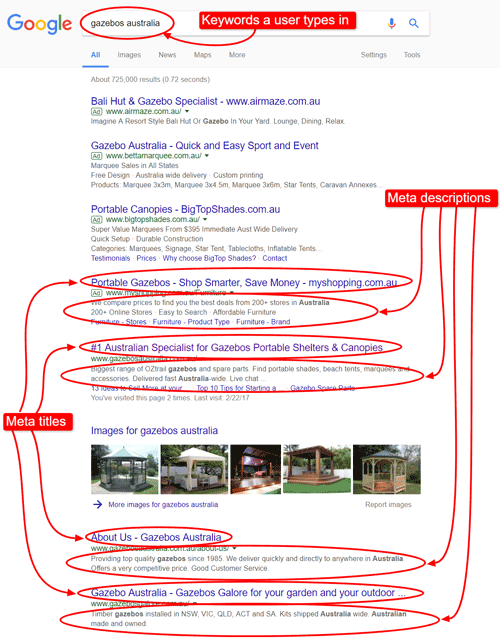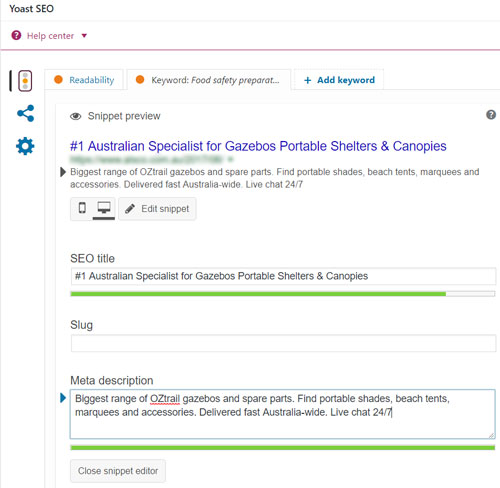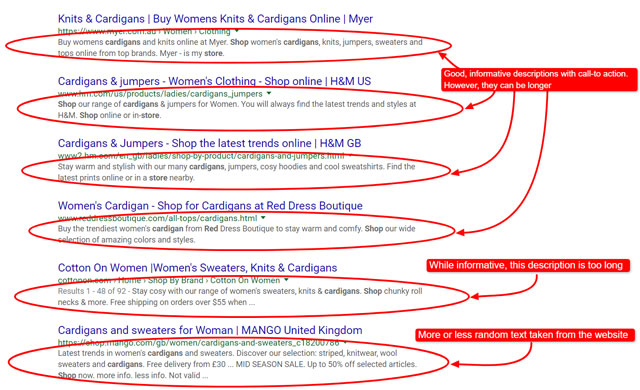
You already know that every web page has its ‘front’ and ‘back’ end. The front end being the appearance of the website that all visitors see and the back end is all the technical stuff that usually Web Developers deal with.
However, if your aim is to be a great, valuable copywriter for eCommerce – and it should be – you need to know that your work doesn’t stop with writing the front-end content.
You will need to write the title and descriptions for product pages that your Web Developer will include in the ‘back end’ of your product page. That text is called metadata.

Why is that important for you?
If you master this skill well, as you should, it will distinguish you from the sea of other Copywriters who don’t have the knowledge and experience in writing this type of data. Writing effective metadata is usually reserved for seasoned experts, so learning this definitely works to your advantage.
Both search engines and potential customers will make a decision about whether your product is relevant for them based on the product page title and description that you write.
First, we’ll go into some more detail about what metadata really is and how it looks like in practice. Then, we’ll give you a few simple rules about how to make good meta titles and some additional sources on it. Once you are done with the meta titles, we’ll do the same with the meta descriptions.
Last, but not the least, you will learn why and how you should write meta titles and meta descriptions together. When you finish this lesson and read up on all the suggested articles and publications, it is highly recommendable that you try and do the exercises, as well. Practice makes perfect!
What Is Metadata?
When you are writing the descriptions for the product pages, you are writing for the website visitors. This means you need to use all the right emotionally charged words and create appealing and interesting descriptions that attract the customers and, ideally, boost the sales.
However, humans are not the only ones you need to write for. Search engines, mainly Google, also needs to know what is on your product page. Search engines, unlike humans, have a little bit different ways of determining whether they “like” or dislike your product.
Why do you want them to like it? Because if they do – they will put your product page very high on the list of the search results for your desired keywords.
Search engines don’t only analyse the content of your metadata, but also the format of that data. These two aspects of your writing need to work seamlessly together for the best results.
Write for people, but format for search engines!
Those descriptions you write for the search engines are called meta descriptions. Just the same, the titles are called meta titles. Together, they are metadata.
In general terms, metadata is more than titles and descriptions. It is data about other data. Namely, it is all the data about objects and texts on your website. For example, metadata about an image is its size, position, resolution and similar information.
Therefore, if you are writing the metadata for a product page, you need to give information about what is written on that page. That information “explains” the search engines and the potential customers what it is that you are selling and how you want it presented.
Let’s say you live in Australia and you want to search for a nice gazebo for your backyard. You will type in “gazebos australia” and the search engine shows you the results.

You may wonder – how and where do I write those meta tags?
Generally, as a Copywriter, you will probably be given a list of product pages in a form of an Google Sheet in which you will write your metadata. Later on, usually a Web Developer will transfer that text into the website header.
This is just an example of such a spreadsheet, but it may be something entirely different. This depends on the way your eCommerce team is organised.

As you can see, this sheet has the character number for each of the titles and descriptions. You will soon find out why when we show you how to write metadata and what is the form you need to follow.
Of course, some eCommerce employers may require from you to write the metadata directly into the website header. If that happens you will probably deal with some sort of plugin for website SEO, like Yoast SEO. Here is how that looks like:

If you want to learn more about this, we encourage you to read a very useful article from WPBeginner about How to Add Keywords and Meta Descriptions in WordPress.
You have probably noticed that there is a certain character number that you should keep in mind and that those title tags have some odd characters in them, like | or – between the words. It is all a part of the many rules about metadata writing that you need to follow.
Therefore, let’s start with the meta titles.
How to Write Good Meta Titles
The best way of writing meta titles always changes. As search engines evolve, you need to keep up with those changes and incorporate them in your work. Therefore, always make sure that you get the latest information about new changes and rules:
SEO Title Tags: Best Practices and Examples https://t.co/cMSLgPaqyP #Unique #Page #Important #Title #Know #TitleTags pic.twitter.com/b1NNy6WRb2
— Aquirr SEO Virginia (@aquirr757) September 21, 2017
Be prepared that you will find a lot of similarities when it comes to meta title tag writing, but also some contradictory opinions, as well. The truth is – people generate those rules based on their experience and the experience of others. That is why they are sometimes not the same.
Here are some general principles about writing proper meta titles:
- Character number – These are the meta titles with proper or improper number of characters. If you want to make your meta visible entirely, you should use not exceed 70 characters. Make the most of those!
- Describe the product properly – Generally, the best title tags include three sections that appear in this order – the product name followed by the short and concise description of the product in question and the company name in the very end. Like this: OZtrail Deluxe Gazebo | 3m x 3m | GazebosAustralia.com.au
- Use the pipe for separation – As you can see from the example above, it is best to use the pipe | for separating these three elements. However, some people choose to use – instead
- Position the keywords well – Try to put your keywords first in your title tags, as much as possible
- Use facts not opinions – Writing that something is ‘the best’ is your opinion. Stating that the same thing is ‘of top quality’ can be a fact. Make sure you always use facts, rather than opinions
- Ease up on the punctuation – Leave out the, and, or, punctuation marks and similar items that don’t contribute to the meaning of your title. They only use up your precious space
- Include your company name – It is best that you always use your eCommerce company name as the last phrase in your title. You can even use some alternatives to your company name. For example, you can use GazebosAustralia.com.au, but also Gazebos Australia or Gazebos & Shelters
- Don’t duplicate titles – Each title on each of your product pages needs to be original
This is just the tip of an iceberg, so you need to read up on this subject and try writing good title tags in order to do your best. Here is some recommended reading:
- Moz: Title tag – MOZ is a big authority on all things SEO. Read it to get a better perspective about what it are title tags and how to write them.
- Neil Patel: How to Create Search Engine Friendly Title Tags – Neil Patel is also an important authority figure that has a lot of useful tips on this topic.
- Search Engine Watch: How to write meta title tags for SEO (with good and bad examples) – In addition to definitions and explanations, you will see a lot of useful examples of title tags that will help you grasp this better.
- The Balance: Common Mistakes to Avoid When Creating Meta Titles – It is always useful to see the common mistakes and to make sure you are not making them.
Some of the recommended reading material also touches the topic of meta descriptions. Therefore, let’s take a look at those, as well.
How to Write Meta Descriptions
Meta descriptions are not so relevant for search engines, as much as they are relevant for attracting potential customers. It is a 155 character long summary of what people can expect to see on your website. It should be well crafted and informative, as well as appealing to website visitors.
This is an example of a nice, but a rather short meta description:

There are many fine nuances about writing meta descriptions. In order to excel in this important task, you can start by carefully reading the All you need to know about meta descriptions (complex guide) from the Spotibo blog. Pay close attention to the section that deals with the eCommerce meta descriptions.
Another very extensive source of knowledge is Hobo Web: SEO Meta Tags Best Practices which contains even some more advanced guidelines about metadata, but it is definitely worth your while.
Here are some general rules that you should follow when attempting to craft a stellar meta description that will help attract the visitors to the eCommerce webstore:
- Description length – You have 155 characters at your disposal. Make the most of them to convey the precise and appealing message for your reader. If you exceed your character count, search engines will not show the entire description and it will look unfinished.
- Add value with your description – It is important that you include enough valuable data about the company and the product page in an elegant way. You need to convey that the product AND the company are both valuable to the website visitor and that they should visit the page. You should sell the product and the business. However, there is no need to include company name in the description.
- Adjust your writing style – Use short and concise sentences without excessive punctuation or keyword stuffing. It goes without saying that you should omit words like ‘and’, ‘or’ and similar, as well as ALL CAPS.
Since Yoast is an excellent and frequently used tool for SEO, it is a good idea to take a look at their blog post that instructs ‘How to create the right meta description‘. Also, check out what Weidert has to say about meta descriptions, as well.
Here are a couple of descriptions that you can analyse and learn from:

As you can see from the last example, Google has taken some random text from the website and used it as a meta description for that page. Sometimes, that happens. It can happen if the search engine ‘decides’ that you have a ‘spammy’ description or an inadequate one.
However, if you follow the rules above, you will significantly diminish the chances of a random description appearing for your product page.
Write Your Meta Titles and Meta Descriptions at the Same Time
As you can see, there is a rule in meta title writing that says the last part of it should contain the company name or some sort of the alternative, like the website name. On the other hand, the rule about meta descriptions says you should NOT include such information.
Why?
Well, you have only a limited number of characters. 155 for your description and 70 for your meta title. You already have the company name in the meta title, so why waste our precious character count to repeat it? There are so many other things that you can write about your product and the company.
That is one of the reasons you should write your descriptions and titles at the same time. After all, they are supposed to work together, aren’t they?

In that way, you can avoid repeating the information. Therefore, you will have enough space to convey your message and add a lot of important details.
Writing all your product titles separately and then all your descriptions would be just like trying to organise an violin and piano concert, but one instrument at the time. You would hold rehearsals separately for the violin and separately for the piano.
How would that sound if these two instruments were to be played together for the first time on their concert?
Well, it might work, but hardly.
Still, it would be far better if they were rehearsed together the entire time, would it?
Writing metadata is a very important part of on-page SEO (search engine optimisation) which plays an essential role in page ranking. The higher page ranking is, the more traffic the product page will receive. More traffic means better chances for more sales.
Here is some additional reading material that is very useful when trying to understand the importance of metadata in terms of SEO.
Backlinko: On-Page SEO: Anatomy of a Perfectly Optimized Page (2017 Update) – This high authority website offers an excellent infographic with precious SEO tips. Below the infographic are excellent tips about on-page SEO and personal experience gems.
Rival IQ: Is Your Meta Description Working As Hard As Your Tagline? – You have to be careful with this one, since it is material from 2015 and that is a bit old. However, you can see the very useful and effective examples, as well as, comparisons of the metadata created by some companies in 2013 and later in 2015. This valuable insight will help you understand the effects your metadata has on search engines.
Ahrefs Blog: On Page SEO: A (2M Keyword) Data Driven Analysis – If you find numbers and statistics more useful, this blog post is ideal for you. A lot of statistics is used to illustrate the elements of on-page SEO and their importance.
Tips and Ideas for Good Metadata Writing
When attempting to write high quality titles and descriptions, try to think about your customers. Think about the benefits they will gain from purchasing your products instead of your competitions’ and also try to understand their motivation for that purchase.
For example, if you are selling tents for camping, list the unique benefits your product has that will persuade the customer that your product meets their needs and fulfills their demands. Those details can be:
- Glow in the dark ropes to avoid tripping
- Super-easy setup
- Extra durable, yet light poles
Since you need to convey the reliability and the professionalism of your company, you should include details such as:
- 24/7 live chat support
- Free shipping
- 12 months warranty
Of course, you need to check with your eCommerce employers and make sure that these offers are true and valid.
Another role that the metadata has is to enable customers to find your product pages. You need to figure out which keywords your potential customers use when they are looking for your product and then include them in your descriptions and title tags.
- Use Keyword Planner to find frequently used words with reasonable competition.
- Use online thesaurus to find alternative ways people search for your product.
- Ubersuggest can help suggest different ideas for keywords
You can find even more useful tips at WPMU DEV 11 SEO Tips for Writing Meta Descriptions That Get More Clicks.
In Summary
A Copywriter with special skills is much more desirable to eCommerce employees than those who can write similar copies and contents like everybody else.
One of the more advanced and very favourable skills for a Copywriter is for them to be able to write metadata for product pages. These includes well-crafted meta titles and meta descriptions.
Metadata is written for both search engines and humans. It should be appealing and enticing, but also formatted in a way that suits search engines.
Well-written metadata will increase page ranking, attract more website traffic and, consequently, boost the sales. That is why this skill is precious for an eCommerce Copywriter.
Avoid using company name since it is already in the meta title
There are several general rules in writing meta titles. These include:
- Make three sections: the product name, a concise product description and the company name in the very end
- Title length – It should be 70 characters long
- Use the pipe for separation
- Put your keywords first in your title tags, as much as possible
- Describe using facts not opinions
- Leave out the, and, or, punctuation marks and similar items
- Include your company name or use some alternatives to your company name
- Don’t duplicate titles – Each title on each of your product pages needs to be original
Logically, there are also similar rules for writing meta descriptions:
- Write meta descriptions at the same time you write meta titles for better combination of these two
- Meta descriptions should not be longer than 155 characters
- Avoid using company name since it is already in the meta title
- Sell your product and your company in your descriptions
- Don’t waste precious characters on punctuation and connecting words
